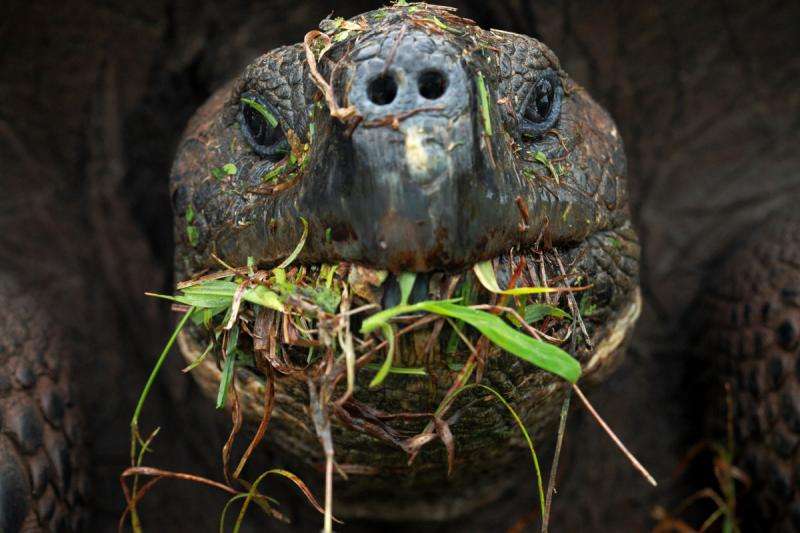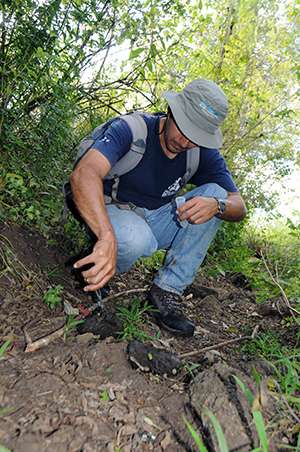Endangered tortoises thrive on invasive plants

Most research on the role of introduced species of plants and animals stresses their negative ecological impacts. But are all introduced species bad actors?
In one fascinating case the answer might be no. The iconic giant tortoises of the Galapagos Islands are thriving on a diet heavy on non-native plants. In fact, the tortoises seem to prefer these plants to native ones.
Introduced plants began to increase in abundance on the Galapagos Islands in the 1930s as native highland vegetation was cleared for agriculture, and the rate of introductions has been increasing ever since.
The giant tortoises, for their part, seem headed in the opposite direction. Until the late Pleistocene epoch, they were found on all the continents except Antarctica. Today they survive in only two locations: the Aldabra Atoll in the Indian Ocean, and the Galapagos Archipelago in the eastern Pacific Ocean. In the Galapagos, all of the remaining subspecies are considered vulnerable or endangered.
But now in a surprising turn of events, field research in the Galapagos shows that introduced plants make up roughly half the diet of two subspecies of endangered tortoise. What's more, these plants seem to benefit the tortoises nutritionally, helping them stay fit and feisty.
The research, published in the March issue of Biotropica, was conducted by Stephen Blake, PhD, an honorary research scientist at Washington University in St. Louis and Fredy Cabrera of the Charles Darwin Foundation in the Galapagos.
"Biodiversity conservation is a huge problem confronting managers on the Galapagos Islands, "Blake said. "Eradicating the more than 750 species of invasive plants is all but impossible, and even control is difficult. Fortunately, tortoise conservation seems to be compatible with the presence of some introduced species."

Counting bites and bouts
The study was done on the island of Santa Cruz, an extinct volcano that is home to two species of giant tortoise, but also to the largest human population in the Galapagos. Farmers have converted most of the highland moist zones to agriculture and at least 86 percent of the highlands and other moist zones are now degraded by either agriculture or invasive species.
In earlier work, Blake had fitted adult tortoises on Santa Cruz with GPS tags and discovered that they migrate seasonally between the arid lowlands, which "green up" with vegetation only in the wet season, to the meadows of the highlands, which remain lush year-round.
"This struck us as pretty odd, " he said, "since a large Galapagos tortoise can survive for a year without eating and drinking. This is why sailors would collect the tortoises to serve as a source of fresh meat aboard ship."
"Why would a 500-pound animal that can fast for a year and that carries a heavy shell haul itself up and down a volcano in search of food?," Blake said. " Couldn't it just wait out the dry season until better times came with the rains?"
The answer, of course, depends on the tortoise's energy balance. But the only detailed study of tortoise foraging the scientists were aware of had been completed in 1980, "largely before the explosion of introduced and invasive species hit the Galapagos," Blake said.
Over a period of four years, the scientists followed tortoises in the field and, during 10-minute "focal observations" recorded every bite the tortoises took, the plant species and which part they ate. As an additional measure of the fruits the tortoises were eating, the scientists also counted and identified seeds (sometimes more than 1,000) in tortoise dung piles.
Counts of bites and bouts (defined as all feeding on a given species during the focal observations) showed that tortoises actually spent more time browsing on introduced species than on native ones.
"We weren't really that surprised," Blake said. "Consider it from a tortoise's point of view. The native guava, for example, produces small fruits containing large seeds and a small amount of relatively bitter pulp in a thick skin. The introduced guava is large and contains abundant sweet pulp in a thin, pliable skin."
The team, which included Sharon Deem, a wildlife veterinarian and epidemiologist at the St. Louis Zoo, also assessed the tortoises' health and nutritional status, weighing them by suspending them from a spring balance and taking blood samples.
All of the indicators the scientists studied suggest that introduced species in the diet have either a neutral or positive effect on the physical condition of the tortoises. Introduced species may even help tortoises to improve their condition during the dry season.
Since a return to "pristine" conditions is unlikely on the Galapagos, it is heartening to learn that this may not be all bad news for the islands' charismatic megaherbivores.
Provided by Washington University in St. Louis


















